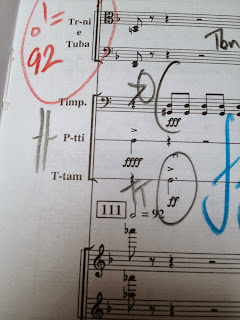I have been threatening it for ages but the time has finally
come – I will play my last concert as a violinist on July 2nd this year, after nearly 23 years as a second violinist.
So what has prompted me to stop playing and what will it
mean?
Quite simply put, it is something I have to do! Conducting
is my passion and it is what I see myself doing for the rest of my life. Nothing
makes me feel happier and more alive than conducting orchestras and I want to
do it 100% of the time.
It must be said that my whole outlook on conducting has been
influenced greatly by my time in the Second Violins of the CBSO. I first
started playing with them in July 1991 and since then I have sat in every seat
within that section, played virtually every piece of standard repertoire, under
literally hundreds of conductors in countless different acoustics. I draw on
all of that experience almost daily as a conductor and use it to my advantage,
wherever possible.
There is no conducting course or class available that can
begin to replicate 20 years experience within a professional violin section.
Notwithstanding the amount of notes I have played, it is the countless hours
watching conductors rehearse and perform from only feet away that have counted
so greatly. I have been lucky enough to have seen some of the greats conduct
from only a few metres away – Rattle, Oramo, Nelsons, Boulez, Gergiev and many
more. To see their stick techniques, rehearsals, attitudes and professionalism,
let alone their musicianship, has been the schooling of a lifetime.
But I have actually learned just as much from the “bad
conductors”..... what?.... Bad conductors, I hear you say? Sorry to have to
tell you this, but not all conductors are brilliant. As one of my CBSO
colleagues says to me regularly, “Mike, you have no excuse – you have seen what
not to do, now go out and do the opposite!”
It is my staunch belief that my time within the CBSO as a
violinist has made be a far better conductor. It could be argued that I should
have retired sooner as a violinist but I would argue otherwise. The last few
years under Andris Nelsons have been invaluable to me – whether assisting him
in the opera performances of Wagner and Strauss, personal help and assistance
or watching him directly, Andris has taught me more about conducting and music
making in the last 7 years than you could ever imagine.
The biggest thanks must however go to the players of the
CBSO. To be able to tap into the thousands of years of experience they
collectively possess, to ask their advice and to feel their support has been
something I have been grateful for. The support I felt from them when I stood
in for Andris, on tour in 2012, was
amazing, especially in the concert with Jonas Kaufmann!
I could not have the
conducting career I have without them and want to publicly thank them for
that. I also want to specifically thank the members of the Second Violins for
their support and friendship over the years – if nothing else, their lives will
be a lot quieter soon, in so many ways!
Will I miss playing?
Yes and No – I will
miss the camaraderie and friendships, touring, playing certain pieces, the
thrill of playing something well, but there are also many things I won’t miss.
A better question might be, “if you had to give up playing or conducting, which
would it be?” – as much as I enjoy playing for an orchestra like the CBSO,
there is only one answer. Having conducted the CBSO for the first time in concert
on 7th March 2003, conducting was all I wanted to do!
I intend to carry on serving the CBSO as their Associate
Conductor for as long as they will have me, along with my other regular
orchestras. While never having been denied time off to go and conduct, I will
now have more time to plan concerts, learn scores and hopefully get the chance
to take on longer projects, like opera. I’m very excited about the future and I
am looking forward to seeing where my conducting career takes me. If it is
anywhere near as exciting as the first 22 years of my career, then I will be very
happy!











